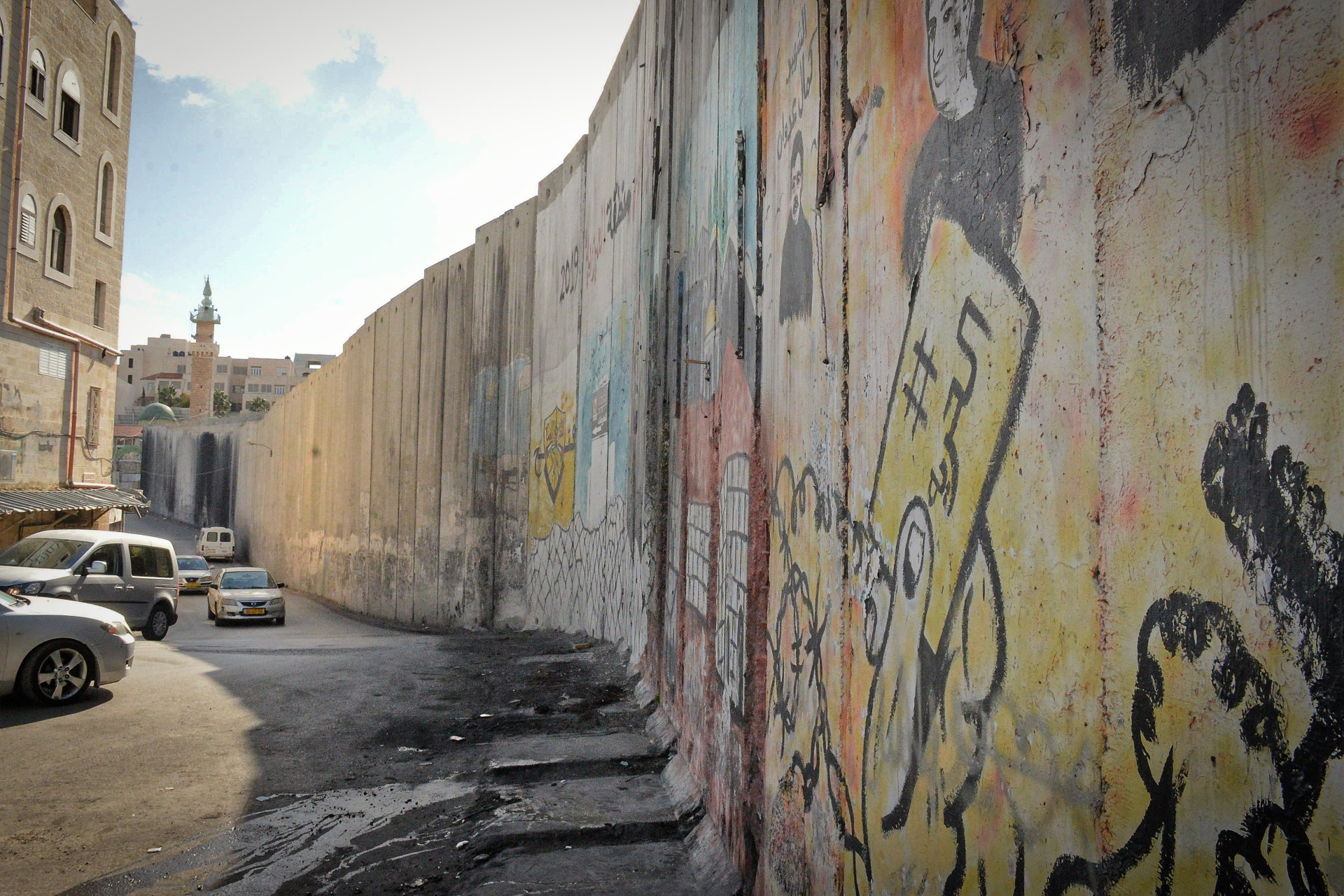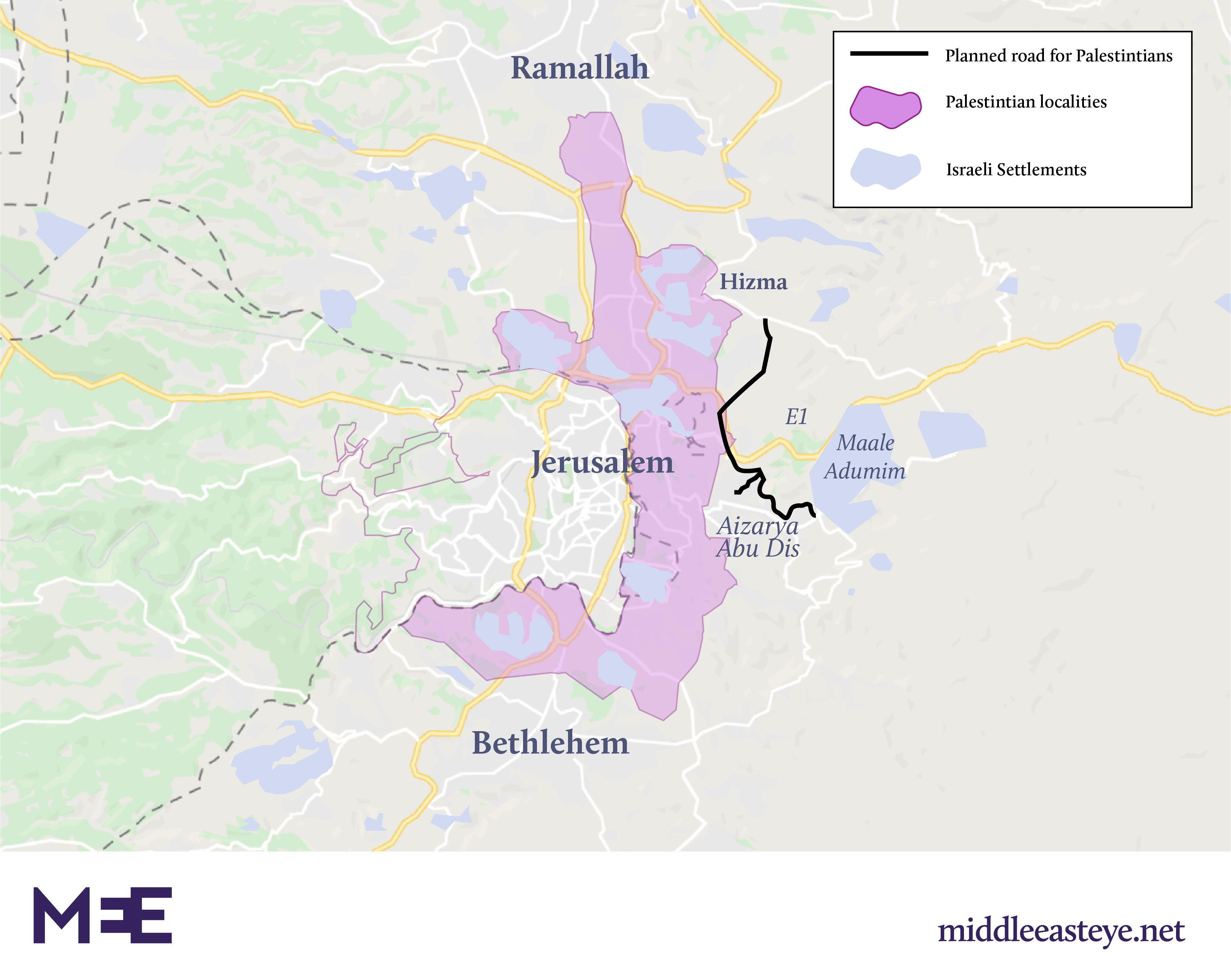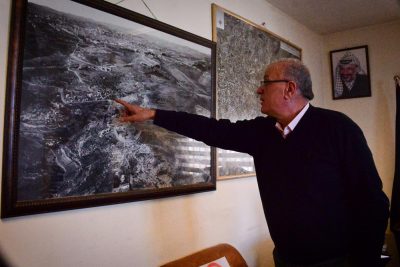Aizarya’s only route to the outside world is to the east via an Israeli-built road, facing the entrance of Maale Adumim, the largest illegal Israeli settlement in the occupied West Bank, built almost entirely on lands belonging to the Palestinian town.
To the west is Abu Dis, another Jerusalem suburb flanked by Israel’s separation wall, which forces all Abu Dis’s traffic to pass through Aizarya and exit east.
Last week, however, the Israeli government approved a project that would build extensive new sections of its separation wall around Aizarya’s north and east, severing it from the Israeli road and direct route to Jerusalem it has enjoyed for centuries, which now would be only accessible to Israeli settlers.
Israel’s government has allocated 14m shekels ($4.3m) for the project, according to Israeli NGO Peace Now.
Aizarya wouldn’t be totally cut off by the scheme. A new entrance to the town and Abu Dis would be erected to the north. That would move traffic towards Ramallah, away from the settlers’ view, and sever it from Jerusalem, the city that Aizarya has always been a satellite of.
“It wouldn’t change much for me, as a minibus driver. I’d still have to drive through this crowded cage to the new way out. But it would cut the town off completely from Jerusalem,” Rabea says.
This is not merely a traffic issue.
By funnelling Aizarya’s people away from Jerusalem and running the separation wall along the edge of the town, the suburb would be further cut off from the surrounding lands that Palestinian residents for centuries have worked and lived on.
The more would see Aizarya’s lands not already settled on by Israel as “effectively annexed”, according to its mayor, Issam Faroun, who says that his town would be “stripped of its lands – to the bone”.
Israel would also be “crippling its urban growth by expropriating the remaining lands the town had left to build on”, he says.
Faroun insists that the new Israeli project is “part of the ‘greater Jerusalem project’ and Israeli annexation plans”.

The Israeli separation wall to the west of Aizarya and Abu Dis (MEE/Qassam Muaddi)
Last summer, Israel appeared set to unilaterally annex parts of the West Bank, including settlements around East Jerusalem such as Maale Adumim. Those plans faltered because of international pressure, and were allegedly delayed as part of Israel’s normalisation deal with the UAE.
However, Israel continues to pursue a longstanding policy of surrounding East Jerusalem with settlements that over time has been cutting it off from the West Bank.
That “greater Jerusalem project”, also known as E1, would see Aizarya’s lands swallowed up for settlement expansion. Eventually, it is believed, Israel intends to annex all settlements ringing East Jerusalem.
“The space they plan to annex is equivalent to the surface of East Jerusalem,” notes Bassam Bahar, an activist from Abu Dis. “The idea is to make the settlements part of the holy city, while leaving us, Palestinian suburban areas, out of it.”
Settlement activities east of Jerusalem began in the early 1970s, after the area was seized from Jordan and occupied by Israel in the 1967 Middle East war.
“Back then, we used to walk to Jerusalem. There were only a handful of settler trailers on two hilltops that the Jordanian government had made public land back in the 1950s,” recalls Faroun. “The Israeli government started expropriating more land around those hilltops and building on them. Those were supposed to be Aizarya’s future urban growth space. Today, it is the Maale Adumim settlement.”
Aizarya has lost 5,000 dunums of land to Maale Adumim, and another 2,000 to a buffer zone between the two that the Israeli authorities created.
The town’s residents were left with just 3,000 dunums of surrounding land on which to live and grow their crops, from the original 11,000 dunums they had before the occupation.

However, Aizarya remained connected to Jerusalem from the west, and to the West Bank cities of Jericho, Bethlehem and Hebron to the east. The main road between both directions crossed through the town.
That changed in the late 1990s, when the entire West Bank was separated from Jerusalem by a checkpoint system, following the Oslo Accords.
That’s about the time Rabea was born. “I remember, growing up, that people would go to Jerusalem through Aizarya and the neighbouring town of Abu Dis,” Rabea says.
“But when the Israelis built the wall in 2005 to the west of the town, it became a dead-end. The town grew more crowded and the main road to Jerusalem became the jammed street that we are now driving on. It often takes an hour to drive from one end of the town to the other.”
Using the last days of Tump
Aizarya’s highly strategic location between Jerusalem and the West Bank has long kept it in Israel’s sights, and its future remains key for any plans to expand settlement blocs around the holy city.
“The Israelis have had this project in mind for years,” says Bahar.
“The only thing which held them back from implementing it was international pressure. We explained the project to several European and American diplomats in 2008. They were all shocked, and pressured Israel to suspend its plans.”
Over the past four years, however, the Trump administration has given Israel almost carte blanche to pursue its expansionist policies at the expense of the Palestinians. Settlement building has skyrocketed, and the Israeli government has been using the final days of Donald Trump’s presidency to push through schemes and projects that would be frowned upon by the incoming Biden administration.
“The Israeli government is using the last days under the Trump administration to push its annexation plans in the east of Jerusalem forward, and it is us who pay the consequences,” Faroun laments. “I can’t plan for the future. There is no future.”
“Back in 1998, we elaborated a full-scale development plan for Aizarya, including a sewage system, housing, jobs and healthcare, but we couldn’t do any of it because we have no space left. All our lands were taken,” he adds.
As Israel has altered Aizarya’s routes over time, the town’s people have suffered the consequences. Children who once attended school in neighbouring towns and cities found the commute impossible, swelling classes in Aizarya and spurring dropouts.
“Our youth used to go to schools in Ramallah in high numbers before the wall was built. Those who had the Jerusalem ID went through the checkpoint every day,” Faroun says.
“After the wall was built, we have had to use roads that take two hours to reach both cities. Education rates dropped dramatically.”
Rabea was one of Aizarya’s affected youth.
“Growing up, I thought more of confronting the settlers and the occupation than I thought of studying. That eventually got me arrested at the age of 18. I was the youngest Palestinian in my prison,” he says.
After his release, Rabea never went back to school. Instead, he began making a living driving passengers through Aizarya’s and Abu Dis’s crowded streets. But history and politics have never left his mind.
“At one point I used to have some hope that these settlements were temporary, that they will withdraw and let us have a country in the 1967 borders,” he says, adding sarcastically: “Yes, I believed that, but at least I have the excuse that I was a kid.”
For Bahar, the story of Aizarya is the story of Palestine – and it has no happy ending.
“This is not only about Aizarya, Abu Dis and East Jerusalem. This is about Palestine never having a chance to become a state,” he says. “It is not about blocking another road or colonising another piece of land. It is about making life so difficult for us here, that we eventually leave.”
Releasing the handbrake and rolling his bus a little further down the road, Rabea insists he’s not going anywhere anytime soon.
“I’m too young to give up,” he says with a resigned smile. “I’m not leaving anywhere.”
*
Note to readers: please click the share buttons above or below. Forward this article to your email lists. Crosspost on your blog site, internet forums. etc.
Featured image: Issam Faroun pointing a 1930s panoramic photo of Aizarya (MEE/Qassam Muaddi)





